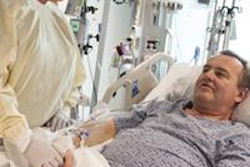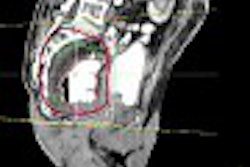SAN FRANCISCO - Prostate cancer research loomed large at this week's American Urological Association meeting, echoing a stubbornly high prevalence of the disease among aging men. The American Cancer Society estimates that in 2004, 230,000 new cases of prostate cancer will be diagnosed in the U.S. alone, and 29,000 men will die of the disease.
Nearly half of patients diagnosed with prostate cancer undergo some form of radiation therapy, including brachytherapy, as their primary cancer treatment. When radiotherapy doesn't work, salvage radical prostatectomy and cryoablation are two other potentially curative options. Another emerging option is multi-agent chemotherapy, by itself and in combination with everything from vitamin D to intermittent hormonal therapy.
The steadily increasing knowledge of prostate cancer pathology is leading to complex new treatment choices -- to the point where the best treatment approach may depend as much on the individual patient's values as on his particular pathology. Thus, after failed radiotherapy, selecting salvage radical prostatectomy over salvage cryotherapy could potentially reflect an individual's preference for continence over sexual potency. Other treatment options pose the age-old question of what is more valuable, a longer life or higher quality of life? Beyond such grim tradeoffs, however, the future is looking bright for a growing number of treatments; several long-term trials in progress are expected to produce more definitive information over the next few years.
"How do we conquer this disease and exploit the advances given to us?" asked Dr. Christopher Logothetis from the University of Texas MD Anderson Cancer Center in Houston. "We're going to have to understand and further study prostate cancer pathology in much more detail than we're accustomed to. What I would propose is that we give a preoperative challenge to the tumor, remove the tumor, understand what it means...in regard to the initial therapy and the probability of later response. Provide the best systemic therapy we can give, assess the response to that therapy with markers that are currently in the clinic...and make a rational decision on whether the patient should receive bone-targeting therapy, additional systemic therapy...or no additional therapy. Many of you will recognize that this strategy of rational development of therapy in a multidisciplinary integrated fashion is a success that has led us to treat well other tumors such as germ-cell tumors and urologic malignancies."
Logothetis and his colleagues found that antiandrogen therapy combined with ketoconazole/doxorubicin alternating with vinblastine/estramustine was better than hormonal therapy alone in patients with a significant disease burden.
A study in 174 patients presented by Dr. Ulf Tunn and colleagues from the Academische Stadtische Kliniken at the University of Aachen in Germany found that intermittent androgen deprivation was nearly as effective as continuous treatment.
Treatments and race
Researchers from the University of Michigan in Ann Arbor and the Beth Israel Deaconess Medical Center in Boston examined the long-term results of 4,788 patients treated with radical prostatectomy, brachytherapy, or 3D conformal radiation, looking for differences in outcomes based on quality-of-life questionnaires. In follow-up ranging from three to eight years, quality of life was generally high for all treatment modalities, though individual results correlated with treatment success. Surgical results were more stable, while radiation results were more variable. No treatment was found to be superior overall, and satisfaction with the quality of care was higher among whites than blacks.
Perhaps the dissatisfaction among blacks was related to their higher incidence of serious disease. A study by Dr. Curtis Pettaway and colleagues at MD Anderson found that in 72 prostate cancer patients matched by age, prostate weight, and preoperative PSA scores, African-American men (n=37) had higher prostate biopsy Gleason scores (≥ 7 in 43%) than white men (n=35), higher probability of having tumor foci in the difficult-to-treat transition zone (67.6% for blacks vs. 42.9% for whites, p=0.057), as well as higher mean tumor volumes (1.82 cc3 versus 0.72 cc3) and 2.8 times greater tumor volume per ng/ml of serum PSA.
The debate: Two options for failed radiation therapy
As many as half of men who undergo radiation therapy for prostate cancer, including brachytherapy, have been shown to have biochemical progression of disease over 10 years, leading to the crucial question of what to do with all of the failed radiation therapy cases, a point of contention that two AUA congress delegates addressed in a debate.
Dr. Aaron Katz and colleagues from Columbia University in New York City presented a six-year study and follow-up of 67 patients (average age, 73.1; average PSA and Gleason scores, 12.20 and 7, respectively). After failed radiotherapy treatment, the cohort underwent targeted cryoablation after failed radiation treatment for prostate cancer, and were followed up between 18-96 months (median 34 months). Some received neoadjuvant hormonal therapy, but these did not impact the results in a statistically significant manner.
The results in a larger cohort of 139 patients since 1995 showed that the median rate of biochemical recurrence-free survival (undetectable PSA values) was 71% at five years, Katz said. In the current study of 67 patients, a third (22) went on to postoperative hormone therapy, and only four were unable to gain control of their PSA. The relatively low rate of comorbidities included incontinence (6.2%, down to 2.3% in the last 86 patients, for whom a warming temperature probe was placed in the external sphincter during the procedure). Penile and scrotal swelling was 12%, initial voiding complications 33.8%, fistulas, 0%, and hematuria 10.4%. Loss of erections was high at 98%, but most patients were already impotent from previous therapy before undergoing cryotherapy, Katz said.
Unfortunately, he said, cryotherapy patients do not tend to regain sexual function over time, even with the use of oral agents. Long-term postoperative procedures for the treatment of urinary function included sphincter replacement in five patients, cytoscopy in 11, and transurethral resection of the prostate in six.
Is radical prostatectomy better?
On the other side of the divide, Dr. Peter Scardino from Memorial Sloan-Kettering Cancer Center in New York City advocated for radical prostatectomy rather than cryoablation. His group, which has been performing salvage radical prostatectomy for many years, presented a paper on the complications and functional outcomes of the procedure over 10 years in 100 patients with failed radiotherapy who underwent radical prostatectomy at the institution. The mean age at the time of surgery was 65 years (mean four years after first radiotherapy), the mean PSA was 10.5 ng/ml, most with a mean Gleason score of 7 or higher. The mean follow-up was 58 months, according to an accompanying abstract.
According to the results of Dr. Andrew Stephenson, Dr. Fernando Bianco, Dr. James Easton, Scardino and colleagues, 75% of the patients remained biochemically disease-free after five years, with complete recovery of continence in 67% over five years. Electron-beam radiation therapy and negative surgical margins were adverse features for the recovery of continence. Nerve grafting did not improve the rate of continence or potency. But over five years, 19% of men recovered their erections, including 49% of those who were potent before surgery. However, there were anastomotic strictures in nearly a third (n=27) of patients, and artificial sphincters were inserted in 20. There were major technical complications in 14 patients including urinary fistula (n=2), rectal injury (7), ureteral injury (4) and obturator nerve injury in one patient. Only 4% of all the group's patients since 1995 have had grade 2 or greater complications.
Stumping for cryoablation
Katz argued in favor of ultrasound-guided salvage cryosurgery, a percutaneous procedure used in the kidneys and prostate that destroys tumor cells by freezing them.
"If you...have excellent ultrasound skills in doing brachytherapy and biopsying your patients in the office, you can take your skills at ultrasound and apply them to cryosurgery," Katz said, noting a number of significant technical advances since he started doing the procedure 10 years ago.
"There are now smaller cryoprobes, 2.4-mm cryoprobes and 17-gauge needles, which allow us to place those probes...percutaneously through the prostate," he said. "We can now monitor the procedure using thermocouples, we can monitor the temperature in and around the prostate, and especially in the external sphincter, which I think is an important part of the procedure in allowing our patients to remain continent following cryosurgery."
With temperature monitoring, urethral sloughing rates are now close to 0%, he said, and improvements in ultrasound have improved the accuracy of monitoring the ice ball, preventing rectal damage. The computer determines the coordinates for needle placement based on outlines of the prostate urethra and the anterior rectal wall. Most patients return home on the afternoon of the procedure.
"We have not transfused a single patient to date following salvage cryosurgery, there has been no reported deep-venous thrombosis, and again the average number of days in the hospital is under one day," Katz said. "There have been significant modifications in the technology leading to dramatic overall improvements in the quality of life. I've seen results in undetectable PSA values in 71% of our patients with long-term, durable PSA results....The procedure can be repeatable in a subset of patients, and although the impotency rates are high, the cancer survival rates are more than 90% at 10 years."
Radical surgery's perception problem
Salvage radical prostatectomy after failed radiotherapy is not widely accepted in the urological community, Scardino said, "I think mainly because of the perception that there's a very high risk of complications around the operation and that long-term morbidity is very high. And there's doubts about whether it's really possible with the operation since in many series the patients have also been given hormonal therapy."
Before they can undergo the procedure, the patient must be early enough in his recurrent disease to be potentially curable, must be highly motivated, in good health, and have a life expectancy of 10 years or more. Radiation cystitis and proctitis are also ruled out before surgery.
PSA (level at surgery, not doubling time) is the most important predictive factor for success at the time of salvage surgery, he said. Eighty percent of patients with PSA of 4 ng/ml or less were rendered free of disease, he said. For PSA of 4-10, long-term success was at 55% of patients. Over PSA 10, only a third of the patients were free of recurrence at five years.
"The other major factor was the pathologic stage of the tumor," Scardino said. “If the cancer was either confined to the prostate or there was extracapsular extension alone without seminal vesicle invasion or lymph node involvement, the patients did very well, 75%-80% of those patients could be rendered free of disease, while only about 20% of patients with seminal vesical invasion or lymph nodes positive were (cured)."
In the last 10 years, Scardino said, the group has gotten better at ensuring that the cancer was confined to the prostate: from 17% in 1994 or earlier to 46% today, another 25% with extracapsular extension alone, he said. Positive surgical margins have improved from 30% in the early series to 8% today. Standard radical retropubic prostatectomy can now be performed in 93% of patients. Bilateral or unilateral nerve-sparing can now be done in 51% of the patients, and the standard hospital stay is three days. Perioperative complications have dropped from 33% to 13% in the last 10 years as well, with only one rectal injury in the last 60 patients.
"But the anastomotic stricture rate remained high, about 30% in both (the early and recent) groups," Scardino said. Incontinence has dropped from 67% to 33% in the more recent series, and is associated with successful nerve sparing. When nerve-sparing was successful, he said, 28% have recovered sexual function. Nerve grafts have not improved potency.
"As we've become more experienced with radical prostatectomy, we can do this operation better, completely excise the cancer, and we're doing a better job of identifying men earlier in the course of disease,” Scardino said. “Modern salvage radical prostatectomy is safe, major complication rates are much lower than they have been in previous years. We have a continuing problem with urinary incontinence, and a delay in diagnosis. Try to get these patients before their PSA gets to four; these are the ideal patients for this operation.”
Katz cautions
Unlike in radical salvage surgery, cryotherapy's impressive record of success has been maintained with only a third of patients who had organ-confined cancer, Katz said, though most of these had extracapsular extension alone, which can be easily treated in cryotherapy. As for salvage radical prostatectomy, it is technically challenging even in skilled hands, he said, resulting in significant morbidity in these patients. Higher and higher doses of radiation therapy are leading to significant scarring around the bladder and prostate, he said, further complicating surgery. Often a salvage cystoprostatectomy may have to be performed, he said.
"Many of the patients who are going to undergo (salvage radical prostatectomy) are older, they have comorbid disease, and they may not be able to undergo such a major surgical endeavor," he said. Moreover, nationwide the anastomotic stricture rate remains at 27%, the rectal injury rate is still at 7%, and the incontinence rate is still far higher with surgery compared to salvage cryoablation. The overall cure rates are the same without undergoing this major surgical procedure, he said, and five-year cancer-specific survival is actually better with cryosurgery, and for the small database of patients at 10 years there is no significant difference, he said.
Scardino's final volley
"I would ask Dr. Katz: does cryotherapy really work?" At five years, Scardino said, "many of the recurrences that are going to happen have just not showed up yet." Second, he said, although modifications of the cryotherapy have reduced the complication rate, "those modifications may result in less-effective eradication of the cancer. If you back off from the urethral sphincter to avoid incontinence, you're leaving the apex of the prostate less well treated, and we know that 85% of prostate cancers are in the apex. If you use the urethral warming device, are you avoiding curing cancers in the transition zone or in the central part of the prostate?" All of these are crucial questions, he said.
"I urge surgeons who are very experienced in radical prostatectomies not to be afraid to perform this (salvage) procedure," Scardino said, noting that salvage surgery is generally no more difficult than surgery in patients who haven't been irradiated. The problem of anastomotic strictures is being addressed by trying to use a non-irradiated part of the bladder for anastomosis, he said. "If you select the patients well, extrcapsular extension is not a problem, you can get around it fully, and you can render patients free of disease for the rest of their life. They've already been burned once; let's don't freeze them twice."
By Eric BarnesAuntMinnie.com staff writer
May 14, 2004
Related Reading
Men take note of prostate cancer in family, April 14, 2004
Fewer
blacks, Latinos treated for prostate cancer, April 9, 2004
Too much vitamin D ups prostate cancer risk, November 14, 2004
Prostate cancer now top male cancer in Britain, March 24, 2003
C-acetate PET opens a new window on prostate cancer, February 15, 2002
Copyright © 2004 AuntMinnie.com



















